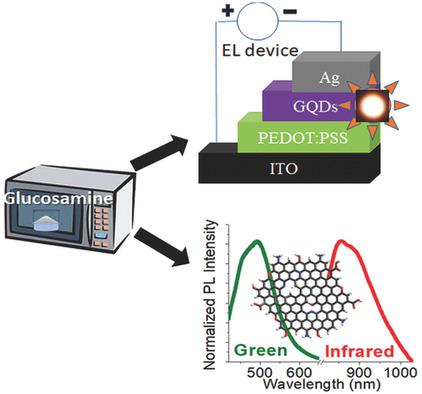当前位置:
X-MOL 学术
›
Adv. Funct. Mater.
›
论文详情
Our official English website, www.x-mol.net, welcomes your feedback! (Note: you will need to create a separate account there.)
Photo‐and Electroluminescence from Nitrogen‐Doped and Nitrogen–Sulfur Codoped Graphene Quantum Dots
Advanced Functional Materials ( IF 19.0 ) Pub Date : 2018-08-30 , DOI: 10.1002/adfm.201804337 Md Tanvir Hasan 1 , Roberto Gonzalez-Rodriguez 1 , Conor Ryan 1 , Nicolas Faerber 2 , Jeffery L. Coffer 3 , Anton V. Naumov 1
Advanced Functional Materials ( IF 19.0 ) Pub Date : 2018-08-30 , DOI: 10.1002/adfm.201804337 Md Tanvir Hasan 1 , Roberto Gonzalez-Rodriguez 1 , Conor Ryan 1 , Nicolas Faerber 2 , Jeffery L. Coffer 3 , Anton V. Naumov 1
Affiliation

|
As opposed to inorganic counterparts, organic quantum dots often exhibit lower fluorescence efficiencies and are complex to synthesize. Here we develop nitrogen‐doped (N‐GQDs) and nitrogen–sulfur codoped (NS‐GQDs) graphene quantum dots exhibiting high‐yield visible and near‐IR emission that are synthesized via a single‐step microwave‐assisted hydrothermal technique with a single glucosamine‐HCl starting material (thiourea precursor used for NS‐GQDs). As‐synthesized N‐GQDs and NS‐GQDs are well‐dispersed (average sizes of 5.50 and 3.90 nm) with high crystallinity and pronounced G‐band. Formed by the bottom‐up assembly of glucosamine, they contain amine linkage and a variety of oxygen‐containing functional groups assessed by Fourier‐transform infrared spectroscopy with ≈2% sulfur for NS‐GQDs. The synthetic procedure allows varying their size and the bandgap. Unlike other graphene‐based quantum dots, these GQDs exhibit bright, stable fluorescence both in the visible and near‐IR with high quantum yields of up to 60%. Excitation‐dependent visible fluorescence is attributed to size‐dependent bandgaps, with near‐IR emission potentially arising from the emissive defect states/their arrangements. Advantageous properties of these GQDs are utilized to develop exciton recombination layer for organic light‐emitting devices exhibiting both photoluminescence and electroluminescence in the visible. Produced by ecofriendly one‐step scalable synthesis brightly‐emissive N‐GQDs and NS‐GQDs become a promising material for novel organic optoelectronics.
中文翻译:

氮掺杂和氮硫共掺杂的石墨烯量子点的光致和电致发光
与无机对应物相反,有机量子点通常表现出较低的荧光效率,并且合成复杂。在这里,我们开发出氮掺杂(N-GQDs)和氮硫共掺杂(NS-GQDs)石墨烯量子点,这些量子点具有高产率的可见光和近红外发射,这些量子点是通过一步微波辅助水热技术通过一次合成而合成的氨基葡萄糖-HCl起始原料(用于NS-GQD的硫脲前体)。合成后的N-GQD和NS-GQD分散良好(平均尺寸为5.50和3.90 nm),具有高结晶度和明显的G波段。它们由葡萄糖胺的自下而上组装而成,它们包含胺键和各种含氧官能团,通过傅立叶变换红外光谱法对NS-GQD进行了评估,含硫量约2%。合成程序可以改变它们的大小和带隙。与其他基于石墨烯的量子点不同,这些GQD在可见光和近红外光中均显示出明亮,稳定的荧光,且量子产率高达60%。与激发有关的可见荧光归因于与尺寸有关的带隙,近红外发射可能是由发射缺陷状态/它们的排列引起的。这些GQD的优越性能可用于开发在可见光中既显示光致发光又显示电致发光的有机发光器件的激子复合层。由环保的一步可扩展合成生产的高发光N-GQD和NS-GQD成为新型有机光电的有前途的材料。在可见光和近红外中均具有稳定的荧光,量子产率高达60%。与激发有关的可见荧光归因于与尺寸有关的带隙,近红外发射可能是由发射缺陷状态/它们的排列引起的。这些GQD的优越性能可用于开发在可见光中既显示光致发光又显示电致发光的有机发光器件的激子复合层。由环保的一步可扩展合成生产的高发光N-GQD和NS-GQD成为新型有机光电的有前途的材料。在可见光和近红外中均具有稳定的荧光,量子产率高达60%。与激发有关的可见荧光归因于与尺寸有关的带隙,近红外发射可能是由发射缺陷状态/它们的排列引起的。这些GQD的优越性能可用于开发在可见光中既显示光致发光又显示电致发光的有机发光器件的激子复合层。由环保的一步可扩展合成生产的高发光N-GQD和NS-GQD成为新型有机光电的有前途的材料。可能由于发射缺陷状态/它们的布置而产生近红外发射。这些GQD的优越性能可用于开发在可见光中既显示光致发光又显示电致发光的有机发光器件的激子复合层。由环保的一步可扩展合成生产的高发光N-GQD和NS-GQD成为新型有机光电的有前途的材料。可能由于发射缺陷状态/它们的布置而产生近红外发射。这些GQD的优越性能可用于开发在可见光中既显示光致发光又显示电致发光的有机发光器件的激子复合层。由环保的一步可扩展合成生产的高发光N-GQD和NS-GQD成为新型有机光电的有前途的材料。
更新日期:2018-08-30
中文翻译:

氮掺杂和氮硫共掺杂的石墨烯量子点的光致和电致发光
与无机对应物相反,有机量子点通常表现出较低的荧光效率,并且合成复杂。在这里,我们开发出氮掺杂(N-GQDs)和氮硫共掺杂(NS-GQDs)石墨烯量子点,这些量子点具有高产率的可见光和近红外发射,这些量子点是通过一步微波辅助水热技术通过一次合成而合成的氨基葡萄糖-HCl起始原料(用于NS-GQD的硫脲前体)。合成后的N-GQD和NS-GQD分散良好(平均尺寸为5.50和3.90 nm),具有高结晶度和明显的G波段。它们由葡萄糖胺的自下而上组装而成,它们包含胺键和各种含氧官能团,通过傅立叶变换红外光谱法对NS-GQD进行了评估,含硫量约2%。合成程序可以改变它们的大小和带隙。与其他基于石墨烯的量子点不同,这些GQD在可见光和近红外光中均显示出明亮,稳定的荧光,且量子产率高达60%。与激发有关的可见荧光归因于与尺寸有关的带隙,近红外发射可能是由发射缺陷状态/它们的排列引起的。这些GQD的优越性能可用于开发在可见光中既显示光致发光又显示电致发光的有机发光器件的激子复合层。由环保的一步可扩展合成生产的高发光N-GQD和NS-GQD成为新型有机光电的有前途的材料。在可见光和近红外中均具有稳定的荧光,量子产率高达60%。与激发有关的可见荧光归因于与尺寸有关的带隙,近红外发射可能是由发射缺陷状态/它们的排列引起的。这些GQD的优越性能可用于开发在可见光中既显示光致发光又显示电致发光的有机发光器件的激子复合层。由环保的一步可扩展合成生产的高发光N-GQD和NS-GQD成为新型有机光电的有前途的材料。在可见光和近红外中均具有稳定的荧光,量子产率高达60%。与激发有关的可见荧光归因于与尺寸有关的带隙,近红外发射可能是由发射缺陷状态/它们的排列引起的。这些GQD的优越性能可用于开发在可见光中既显示光致发光又显示电致发光的有机发光器件的激子复合层。由环保的一步可扩展合成生产的高发光N-GQD和NS-GQD成为新型有机光电的有前途的材料。可能由于发射缺陷状态/它们的布置而产生近红外发射。这些GQD的优越性能可用于开发在可见光中既显示光致发光又显示电致发光的有机发光器件的激子复合层。由环保的一步可扩展合成生产的高发光N-GQD和NS-GQD成为新型有机光电的有前途的材料。可能由于发射缺陷状态/它们的布置而产生近红外发射。这些GQD的优越性能可用于开发在可见光中既显示光致发光又显示电致发光的有机发光器件的激子复合层。由环保的一步可扩展合成生产的高发光N-GQD和NS-GQD成为新型有机光电的有前途的材料。



























 京公网安备 11010802027423号
京公网安备 11010802027423号